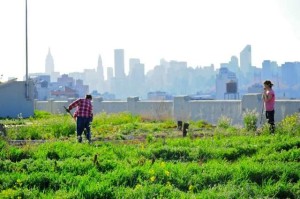Industrial Food and Evolution


Back in 1748, William Cullen invented the first known refrigeration system at the University of Glasgow. Today, the refrigerator is something many take for granted. Probably, not much thought is given to refrigeration, but when you pause and think about it, heating and cooling has made one of the biggest contributions to modern society and in particular, society’s ability to be mobile.
In the early 20th century, (and way before that, too) people lived near towns and villages and went to the market daily for their meats, cheeses and eggs; items that would spoil if not eaten soon. A relationship developed with the shopkeepers – they conveyed knowledge of foodstuffs, preparation and daily news. Employment centers were located where food was available. Fast forward to 1916 when Clarence Saunders opened the first supermarket, Piggly Wiggly, and the world became both smaller and larger at the same time (however perishable food items were not available till the 1920s). With the ability to keep food cool (temperature food usually kept at), people could move further out and store food in their new Frigidaires. Grocery stores could open and cater to new villages and towns. So in a way, the frozen food section has contributed to suburban expansion. For better or for worse. Refrigeration meant workers and their families could move further outside the town limits. Cities grew; suburbs grew.
But it suddenly (within the past 5 or so years) seems hip to do things the old fashioned way. Although I don’t think city dwellers will return to storing their frozen food in ice houses down by the East River. At least I hope not. There is a sweep of urban agriculture casting its net across NYC and many other urban areas across the states. Even corporations like Whole Foods are getting in on the act. I grew up on a farm in the Midwest, one that raised soybeans, wheat, and hogs; so this rooftop farming seems more like industrial gardening to me. Spinach, lettuce, and other crudité are taking to the skies, bathing in hydroponics or even aeroponics in some setups.
I see the benefits – trying to encourage and promote fresh produce in diets, especially for children and in low-income areas; transportation costs are cut since fruits and vegetables don’t have to be trucked or flown in; and emissions, such as greenhouse gases are reduced. I question how big of a dent rooftop gardening could have on transportation costs and deliveries at this stage. And how clean is the food sitting up on a rooftop in a dirty, smoggy city?

A bigger issue I think we have to tackle is that of food waste. Mayor Mike Bloomberg has challenged restaurants to participate in a new city program designed to reduce the amount of food waste sent to landfills. More than 100 restaurants have signed on so far.
Food security is a concept that many nations, including developed nations such as Australia and the United States are dealing with. In the U.S., one in four kids are hungry and do not have enough to eat. A film that really drives home the current status of food policy in America was released this past March. It’s called A Place at the Table and was produced by Top Chef star, Tom Colicchio. I highly encourage you to check it out, whether you live in Australia, Spain, Turkey, Kenya or the U.S., food is an issue central to people around the globe.
The Food and Agriculture Organization of the United Nations released a report entitled The State of Food and Agriculture 2013. It attempts to address the attire by shining light on nutrition, production, the supply chain, and even the governance of food systems. As the report states, “Malnutrition in all its forms – undernutrition, micronutrient deficiencies, and overweight and obesity – imposes unacceptably high economic and social costs on countries at all income levels.”
If cities are going to continue to grow and prosper, getting a handle on our food production, supply and storage is critical. Refrigeration, transportation, utilizing the full potential of land and buildings and determining the best policies are the pieces of the portfolio needed to promote healthy and sustainable societies. The time for action is now.
Burnes K (2013-06-10 00:39:22). Industrial Food and Evolution. Australian Science. Retrieved: Jul 03, 2025, from http://ozscience.com/health/industrial-food-and-evolution/
 Follow
Follow